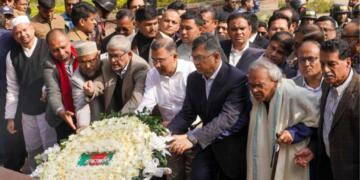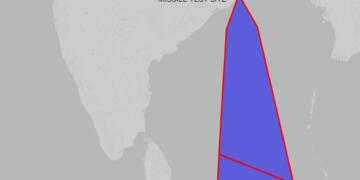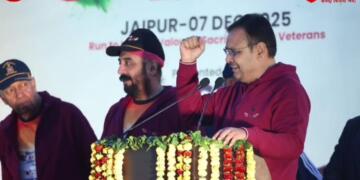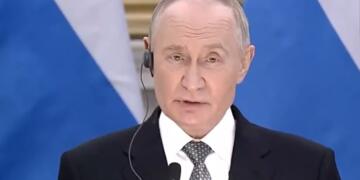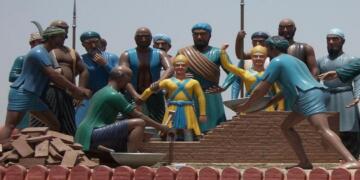USAID funding scandal: In the last part of our series on Deep State, we explored how civil society and NGOs have been weaponized to serve political interests worldwide. This part delves into how the American deep state has orchestrated disturbances across key global regions—from Ukraine to India—using a mix of covert funding, political manipulation, and narrative warfare. By leveraging media, NGOs, and strategic alliances, the deep state has destabilized governments, engineered conflicts, and influenced socio-political landscapes to maintain global dominance.
Key Countries and Disturbances
Ukraine
Ukraine has been a focal point of U.S. foreign policy in the Eastern Europe region, especially since the 2014 Euromaidan protests. Just for the sake of controlling Russians, the American deep state has funded countless NGOs, media outlets, and political organisations in Ukraine to promote pro-Western policies and counter Russian influence. The narrative war, culminating in Kamala Harris communicating the welcoming of Ukraine into the NATO fold at the Munich Security Conference, proved instrumental in reigniting the brutal but brotherhood war between Ukraine and Russia.
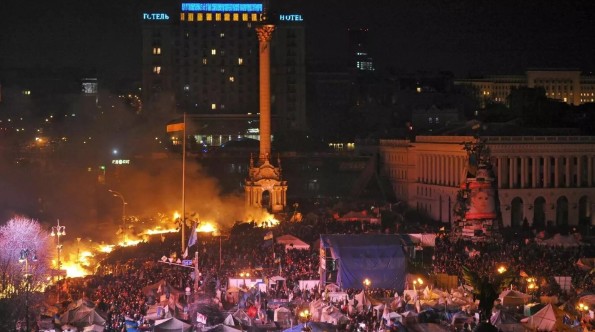
Cuba
The U.S. deep state has a decades-long history of attempting to destabilise the Cuban government under the Castros. This has included everything from covert operations and economic sanctions to media manipulation, assassination attempts, and funding opposition groups. Even with modern warfare techniques, the global behemoth used a social media website to instigate people against the ruling dispensation, as if hunger, starvation, and diseases caused by their blockade were not enough.
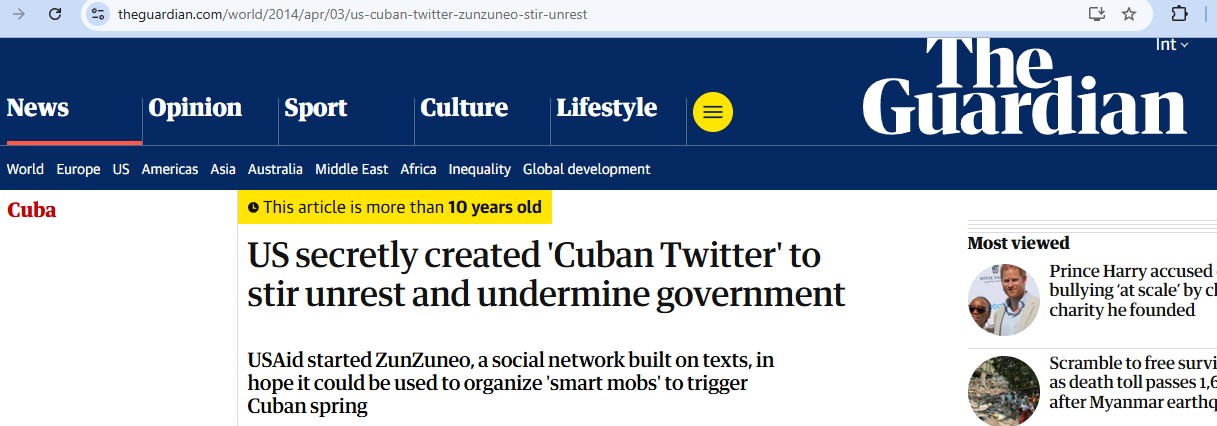
Afghanistan
Its attempts to instigate regime change in USSR’s neighbourhood brought Americans into Afghanistan during the 1980s, when they funded the Afghan Mujahideen to fight against the Soviet Union. It backfired for them in the failure to control the Taliban and ultimately stop 9/11. They returned again after 9/11 and introduced a mix of wokeist and military playbooks but failed again, ending up making the lives of Afghan women a living hell under the Taliban. The extremes to which the Taliban has gone to control Afghan women are connected with the way Americans used Afghan women for their wokeist agendas.
Syria
In Syria, the military-industrial complex used everything in its power – from funding opposition groups to creating soft assets – to counter the Assad regime. However, Russians under Putin resisted it, but the U.S. got its opportunity when Russia became engrossed in the Ukraine war. Americans then used Al-Sharaa, a man in whose name they had put a bounty of $10 million, to topple Assad.
Italy
Italy, being the autocratic lab of Benito Mussolini, remained on the American watchlist for quite a long time after World War II. The American government was deeply involved in Italian politics to prevent the rise of a pro-Soviet government. The CIA funded political parties, media outlets, and even the mafia to ensure that Italy remained aligned with the West.
Latin America
The manifestation of greed to control the world begins with the first step in neighbourhood Latin America. To keep these countries in check, the U.S. has used tools like soft diplomacy, allowing migrations, going soft on drugs, funding opposition groups and media outlets, and orchestrating coups and assassinations.
Middle East
The Middle East is one of the biggest nuclei and a place to test their strength for the American deep state. The rise of the oil economy, coupled with the need for big oil-producing nations to secure their borders and ensure economic growth as well as integration with global systems, has kept Americans’ interest in this geography. They have overseen dozens of conflicts, played roles in regime change operations, sent troops as ruthless mercenaries, and then used NGOs to ensure a soft image in the eyes of rulers.
Eastern Europe
American interest in Eastern Europe is, in one way, an example of the white man’s burden. The Western European world, led by Americans, who are their descendants, wants Eastern Europeans to follow them, which is not feasible for most. Eastern European countries are a bit more patriotic and less tilted towards money, which is why family systems and religion are stronger there. Modern American elites don’t like it as they see the region as an investment opportunity for oil and natural gas, while Eastern Europeans’ perennial problem is anxiety around securing borders. The American deep state has learned to manoeuvre and utilise this anxiety for its financial gains.
Africa
In Africa, American deep state interest mainly lies in the extraction and use of minerals like bauxite, cobalt, industrial diamonds, phosphate rock, platinum-group metals (PGM), vermiculite, and zirconium, among others. Most expensive electronic equipment has African blood imprinted on it, and Western powers want to keep it that way for at least a century. Currently, their stakeholders in the region include companies, government armies, UN Peacekeeping forces, NGOs, lawyers’ bodies, funded opposition groups, private militias ready to take down ruling governments, and missionaries, among others.
Southeast Asia
In its efforts towards suppressing communism, Americans played a destabilising role in Southeast Asia, particularly in Vietnam, Laos, and Cambodia, through methods such as military intervention, covert operations, and economic manipulation. American agencies funded propaganda, ethnic tensions, and dissident groups, fuelling internal conflicts. While backing authoritarian regimes, U.S. counterinsurgency efforts worsened political instability across the region. These actions, aimed at suppressing communism, left long-term economic and political consequences in Southeast Asia.
Deep State eye on India
The United States Agency for International Development (USAID) has been a significant player in India’s political landscape as its activities extend beyond traditional development assistance into areas that influence India’s political, social, and religious dynamics.
Reports indicate that between 2008 and 2024, USAID disbursed approximately $275.48 million to 54 Indian entities, including NGOs, media outlets, educational institutions, and individuals, primarily based in New Delhi.
This funding has been directed towards organisations such as the Asian College of Journalism (ACJ) in Chennai, which received financial support from the Omidyar Network, an organisation linked to the Indian National Congress party and Alt News, a fact-checking website. The Omidyar Network, founded by eBay billionaire Pierre Omidyar, has been a significant conduit for USAID funds, raising concerns about potential biases in journalistic training and media narratives emerging from ACJ.
USAID’s involvement in India’s political landscape has been extensive, with funding directed towards various NGOs, media outlets, and civil society groups. Former U.S. diplomat Mike Benz has highlighted USAID’s controversial activities under Administrator Samantha Power, alleging that Power facilitated illegal immigration into the United States.
In the Indian context, Benz pointed to a coordinated campaign by USAID and the U.S. State Department against Prime Minister Narendra Modi ahead of the Lok Sabha elections. This campaign involved funding various NGOs, media outlets, and civil society organisations to create narratives that could sway public opinion against the incumbent government.
Prominent Indian journalists and activists, including Ravish Kumar, Pratik Sinha, and Prashant Bhushan, have been associated with Internews, an organisation reportedly funded by USAID. Documents released by WikiLeaks reveal that these individuals were part of initiatives aimed at disseminating anti-India propaganda under the guise of promoting free speech and democracy.
An exclusive investigation uncovered that an NGO led by Sam Pitroda, a known advisor to the Indian National Congress party, received funds from USAID and the U.S. State Department. This financial backing sparked debates in the Indian Parliament, with lawmakers demanding thorough investigations into the potential misuse of foreign funds to influence India’s political discourse.
USAID’s support for faith-based organisations has also been significant, with World Vision, a prominent Christian humanitarian organisation, receiving billions in funding. Critics argue that this financial support has been utilised to convert Hindus in India, with historical references to the tenures of former Prime Ministers Jawaharlal Nehru and Indira Gandhi, who purportedly curtailed such activities. Investigations have revealed that certain churches and faith-based groups received substantial funds from USAID, which were allegedly used for conversion activities. These organisations are also accused of supporting extremist elements, including jihadis and Naxalites, posing a threat to India’s internal security and social harmony.
Historical analyses draw parallels between USAID’s current operations and its past activities in regions like Laos during the Vietnam War era. Reports suggest that under the pretext of international development, USAID was involved in covert operations, including funding militias and facilitating drug trafficking in the Golden Triangle. These historical precedents raise concerns about the true intentions behind USAID’s initiatives in India and other developing nations.
WikiLeaks disclosures have exposed collaborations between USAID and media organisations such as Internews on projects like ‘Factshala’. Prominent media figures, including Shekhar Gupta and Faye D’Souza, were associated with these initiatives. Critics argue that such collaborations may serve as conduits for propagating specific narratives under the banner of fact-checking and media literacy, potentially skewing public perception.
The Organised Crime and Corruption Reporting Project (OCCRP), an international investigative journalism consortium, has also come under scrutiny for its funding ties to USAID and entities associated with George Soros. In December 2024, OCCRP published reports targeting the Adani Group, a major Indian multinational conglomerate. These reports were perceived as attempts to undermine India’s economic interests and destabilise the government led by Prime Minister Narendra Modi.
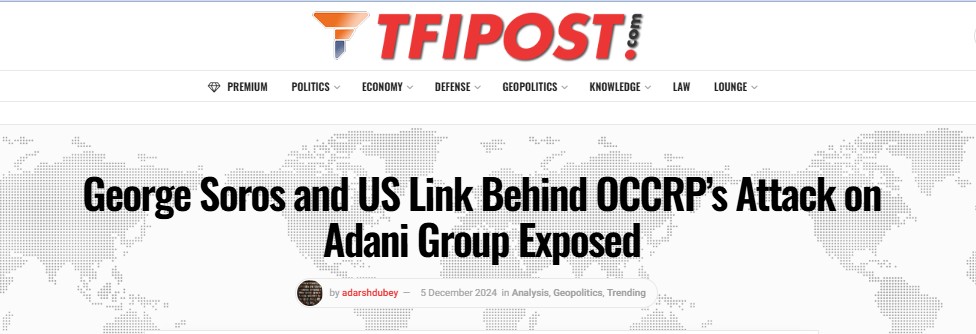
Further claims indicate that USAID has been involved in promoting specific media narratives and fact-checking initiatives in India. A ‘Disinformation Primer’ allegedly associated with USAID recommended strategies such as ‘strategic silence’ and ‘fact-checking’ to influence public opinion. The U.S. State Department implemented a project starting 1 September 2024, in five Indian cities—Kolkata, Hyderabad, Chennai, Mumbai, and Delhi—aimed at recruiting fact-checkers as part of a ‘targeted digital literacy and resilience programme’.
Political figures have voiced concerns regarding USAID’s activities in India. BJP Member of Parliament Nishikant Dubey alleged in the Lok Sabha that USAID funded anti-India elements aligned with the Indian National Congress party. He called for a thorough investigation into the matter, highlighting potential collaborations between USAID, George Soros, and opposition parties in India.
The farmers’ protests that erupted in late 2020 provide another example of USAID’s alleged involvement in India’s internal affairs. The protests were a response to three agricultural laws introduced by the Indian government, which farmers feared would dismantle the Minimum Support Price (MSP) system and leave them vulnerable to corporate exploitation.
While the protests were primarily driven by domestic concerns, there have been allegations that external entities, including USAID-funded organisations, played a role in amplifying the dissent. Critics argue that certain NGOs and civil society groups, receiving funding from USAID, provided logistical support, mobilisation strategies, and international advocacy platforms to the protesting farmers, thereby intensifying the movement and drawing global attention to it.
In addition to the farmers’ protests, USAID’s involvement has been questioned in other significant movements within India. For instance, the Agniveer initiative, a government programme aimed at recruiting youth into the armed forces on a short-term basis, faced substantial opposition and protests.
BJP MP Nishikant Dubey asserted in the Lok Sabha that organisations funded by USAID were instrumental in orchestrating protests against the Agniveer scheme. He claimed that these organisations not only opposed the initiative but also backed other contentious issues such as a caste-based census and even supported Naxalism in certain regions.
Further compounding these concerns are revelations from the former U.S. State Department official Mike Benz. Benz has alleged that USAID, along with other U.S.-backed organisations, has actively interfered in the domestic politics of nations like India and Bangladesh. He claims that under the guise of promoting democracy and countering misinformation, USAID funded programmes that were designed to suppress nationalist movements, including India’s Bharatiya Janata Party (BJP).
According to Benz, initiatives purportedly aimed at enhancing digital literacy and resilience were, in reality, efforts to curb pro-government narratives and bolster opposition voices.
The modus operandi of such influence is not always overt. USAID’s funding mechanisms often involve grants to local NGOs, media outlets, and civil society organisations. While these grants are officially intended for developmental and humanitarian projects, there have been instances where the funds have allegedly been diverted towards activities with political undertones.
For example, certain media organisations receiving USAID support have been accused of promoting narratives that are critical of the Indian government’s policies, thereby shaping public opinion in a manner that could foment dissent. Similarly, workshops and seminars funded under the pretext of capacity building have, at times, been platforms for discussing strategies to challenge governmental initiatives.
Also Read: This Week in Focus: The Deep State Playbook Part 4 – How NGOs Fuel Global Unrest
The concerns are not limited to political protests alone. There have been instances where USAID-funded organisations have been linked to activities that question India’s internal security measures. For instance, some NGOs receiving USAID support have been accused of backing movements that challenge the state’s actions against insurgent groups.
Such support not only undermines the government’s efforts to maintain law and order but also emboldens groups with separatist or extremist tendencies. In response to these allegations, there have been calls within India for a thorough investigation into USAID’s funding patterns and the activities of its partner organisations.
Lawmakers and political leaders have urged the government to scrutinise the flow of foreign funds into the country, especially those directed towards entities that engage in political advocacy or protest mobilisation. The objective is to ensure that foreign aid is utilised strictly for developmental purposes and does not interfere with the nation’s internal political dynamics.
It’s essential to recognise that while USAID’s official mandate centres on promoting development and humanitarian assistance, the line between aid and political influence is not something Americans are known for adhering to. It is in fact their default setting and a key part of their psyops.
Americans don’t live in reality. They want to change everyone’s reality according to their imagination. That is the reason why becoming their enemy provides more stability to one’s foreign policy than becoming the enemy. Ukraine understands it and so does every country in the world.
As Henry Kissinger himself said, ‘It may be dangerous to be America’s enemy, but to be America’s friend is fatal.’





